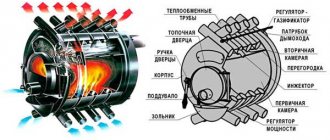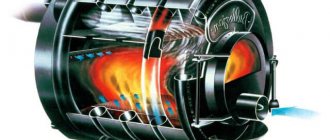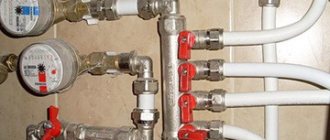The variety of choices and wide range of pipeline fittings available on the modern market allows you to make the right choice among different types of valves, depending on the scope and characteristics of the application. A special gate valve, presented on our website in a broad classification, is an important and widely demanded mechanism for regulating the flow of contents of various pipelines, without which large industrial enterprises of a public and private nature, as well as smaller public utility organizations, cannot do.
The gate valve gets its name from the German term “schieber” (gate), derived from the verb “schieben”. The literal translation into Russian of this concept means to push, move or thrust. Thus, a gate valve means a damper made in the form of a sharpened plate that can be moved. Due to the special sharpened shape of the working body, this valve is often called a “knife gate valve”.
In accordance with the established domestic GOST 24856-2014, the definition of a gate valve includes all pipeline fittings that have the form of parallel pointed plates with a locking element. The main purpose of such fittings is to block the flow of pipeline contents (air, water, gas or any other working medium). Slide valves are often used to control the flow of media that have a heavy and even viscous consistency.
What is a gate valve
The gate valve includes a mandatory element - a gate. The specification of this device, based on its technical documentation, implies the presence of a moving plate made of durable steel. The valve allows you to completely or partially block the flow of the working medium and regulate the size of the passage opening, and, accordingly, the amount of content passing through it.
One of the common examples of using a gate valve with a gate element is to shut off the flow of cement or other bulk medium in an industrial installation. It should be noted that this case can be safely called a standard for the scope of use of such valves - these are “dirty” granular and pulp media.
Thus, a slide valve, which is also often called a knife gate valve (which, however, does not entirely correspond to the GOST terminology), is a mechanism that blocks the flow of pipeline contents with an admixture of various components. The design of the gate mechanism includes parallel knife plates, the movement of which is perpendicular to the axis of the main flow. The pointed shape of the plates allows you to expand the functionality of dampers of this type. Thus, these valves can block the flow of contents and at the same time crush or stop the movement of large solid particles, as well as crystalline components and impurities.
Advantages and disadvantages
The advantages of gate valves are:
- ease of manufacturing the shutter;
- ease of assembly, disassembly and repair;
- no jamming of the shutter in the fully closed position.
The disadvantages of gate valves are:
- high energy consumption for opening and closing, caused by the fact that along the entire path of movement the drive overcomes friction between the sealing surfaces of the seats and the shutter;
- significant wear of the sealing surfaces.
Despite their disadvantages, gate valves are quite easy to maintain and repair. The amount of wear can be very easily compensated for during repairs by displacing (unscrewing) the seats.
Methods of use
Gate valves with a gate design are used in treatment and filtering installations and various pipelines (usually of the “dirty” type). This means that durable and reliable dampers do an excellent job of blocking the movement of powerful mud flow. They can be installed on pipelines carrying high pressure
refers to rock, oil, all kinds of liquids with granules, pulp and other impurities, solid inclusions and particles.
Based on the diverse range of pumped media, gate valves are classified into models intended for use in various industries. In particular, the most popular areas of use of such valves are:
- chemical industry;
- oil and gas industry;
- production of building materials;
- public utilities;
- mining industry;
- pulp and paper industry;
- electric power and so on.
Gate valves, due to their ability to filter and crush particles passing through it, as well as to pass large volumes of working fluid, are widely used and used in sewer systems and drains. They are also quite in demand for chemical plants, where they are equipped with technological lines for the production of ammonia, mastics, acids and all kinds of mineral fertilizers. In the mining industry, gate valves help filter and dispense useful components, preparing them for subsequent processing.
A separate area of application, which is regulated by regulatory documentation GOST 55020-2012, is the oil and gas industry. In this area, gate valves are used on main pipelines as part of Christmas tree fittings
Self-manufacturing of valves
Before manufacturing a horizontal valve, the cross-section of the smoke channel is first accurately measured and a fragment is precisely cut out along it.
Then the resulting plate is welded to two pipes in which it will be located after installation. Making a rotary gate will be more difficult. First, the frame for the damper is welded. For this, corners with a shelf width of about 35 millimeters .
Then the holes for the axle are drilled. When a corner gate is needed, the holes are made diagonally. When the gate is required to be straight, the holes must be parallel, in the middle of the welded frame.
Then the bushings are attached. Be sure to check that they are placed correctly. The axle should rotate internally without difficulty.
Then the damper itself is manufactured. By preparing a plate based on measurements of the pipe cross-section.
The plate is inserted into the frame and welded to its axis. In this case, there should be no significant gaps, no more than 1 millimeter .
At the next stage, a limiter must be welded to the damper to completely close it.
After this, a handle is attached to the axis; when turned, the gate will rotate.
Design of gate valves
The standard design of any gate valve involves the movement of the valve element perpendicular to the direction of flow of the pipe contents. All valves of this type, due to their use in large industrial areas, are made from materials that do not corrode and are also resistant to various temperatures, aggressive chemical environments and negative environmental influences.
Strict consumer requirements for these shut-off valves predetermine high quality standards for the manufacture of gate valves, which must be reliable, durable, strong and have a long service life (more than a dozen years). The main materials for the manufacture of gate valves are:
- cast iron or cast iron alloy with spheroidal graphite of high quality;
- steel (stainless, carbon, low-alloy);
- non-ferrous aluminum alloys;
- polyvinyl chloride (PVC);
Also, to extend the service life of metal plates, polyester, epoxy and anti-corrosion protective coatings are used.
The design of a gate valve includes the following main components:
- knife plate - gate;
- outer casing;
- seal element;
- stuffing box sealing unit;
- rack.
Additional parts used in the design of the gate valve mechanism are:
- threaded bushing;
- casing;
- pointer;
- spindle (rod);
- flywheel;
- oil seal cover;
- O-rings.
Installation recommendations
When installing gate valves in a pipeline, the following recommendations must be observed:
- Before installation, you should make sure that the connecting flanges are cleaned of dirt, scale, rust, and there are no scratches on them.
- You should also check the linearity of the pipeline - the valve is not designed to align it, and if it is installed at misaligned ends, there is a high possibility of leaks and even cracks in the body.
- Water hammer in the system, which can be caused by rapid opening of valve gates, should be avoided.
- It is advisable to tie the bodies of heavy shut-off valves with a soft tape sling. Under no circumstances should the valve be secured to the handwheel or actuator.
- During installation, you should avoid impacts and friction - this can lead to the destruction of the protective coating of the housing and its accelerated corrosion.
- Be sure to install the fittings along the arrow on the body, indicating the direction of movement of the transported flow.
- Gate valves are supplied with a loose gland. All bolts must be tightened before installation.
- The gate valve can be installed in any position with the exception of the vertical bottom.
- For heavy products of large dimensions installed horizontally, supporting supports should be provided.
Rice. 18 Installation rules
Gate valves are widely used in many industries and the national economy, where gases and clean or contaminated liquids are transported through pipelines and without them. Due to the wide range of uses, gate valves have a fairly large number of design options, materials for manufacturing the main components, which are bodies, gate valves and seals.
Operating principle of gate valve
The simple and at the same time reliable principle of operation of gate valves largely predetermined their high popularity and indispensability in the organization of pipelines, designs of production and industrial installations, as well as sewer and other systems. So, the valve is always installed perpendicular to the flow of the working medium (air, liquid, gas with various impurities and components). Under manual mechanical or automated influence, the force from the rod or spindle is transmitted to the gate element, which is driven and completely or partially blocks the passage of the contents in the pipe. At the same time, a spindle installed in a limited space may not have a retractable design. In this case, the tightness on both sides of the gate is ensured by the pressure of the working medium. Also, a tight and reliable connection is achieved through the use of an oil seal made of synthetic fiber, dry or oiled cotton fiber, as well as graphite and other materials.
A polished and sharpened gate, shaped like a knife or guillotine, performs a smooth sliding movement between the working medium and the seal. Such a device helps to avoid temporary delays in the operation of installations or pipelines. The sharp ends of the gate with a strong seal ensure smooth and uninterrupted operation of the valve, reducing the likelihood of premature wear of the main working element, especially in the presence of aggressive environments, as well as many large components and impurities.
Materials for the manufacture of gates
Basically, valves for stove heating are made from steel . The advantages of this material include:
- Good thermal conductivity;
- Resistance to high temperatures;
- Sufficient strength characteristics;
- Resistance to corrosion;
- Low coefficient of thermal expansion.
Sometimes gate valves are made from other metals, but, more often than not, they are inferior in their performance characteristics.
For example, cast iron gates are very heavy. Hence the difficulty arises when installing them into ready-made structures. Their scope of application is limited to brick pipes.
Classification of gate valves
The valve body is one of its main parts, which protects internal elements from mechanical damage and external influences. The body shape can be made in the form of a cylinder or a rectangle. Various housing options for valves can be made either monolithic (single, solid), or in prefabricated or welded construction. Some manufacturers offer combined versions of protective housing parts.
Based on the type of gate valve installed (closing element), gate valves are divided into plate and plate gate valves. The group of shut-off valves with plates is also divided into “knife” and “guillotine”. The first type of valve with a gate valve in the form of a monolithic slab has in its design a hole into which a pipe installed on the opposite side fits. Knife and guillotine gates have a pointed shape in accordance with their name - in the form of a knife or a blade sharpened at an angle (like a guillotine).
The installed seal classifies the valves into metal/metal and metal/synthetic categories. The type of sealing element used is very important to create a perfectly tight seal when closing the valve. The following synthetic materials are used for the production of slide-type seals:
- nitrile rubber is a chemical-resistant material;
- ethylene propylene diene rubber (EPDM/EPDM);
- rubber mixtures with the main component SKN for hot environments;
- frost-resistant material Viton;
- silicone
According to the method of control and operation, the following types of dampers are distinguished: manual gate valve and gate valve with automatic drive. The manual type of control requires the presence of a mechanism with which you can adjust the position of the gate in the valve. The following mechanism is used:
- square or round nozzle;
- valve with flywheel;
- steering wheel with static or retractable stem;
- lever arm;
- T-shaped key.
Valves with automatic or mechanized control may have:
- pneumatic drive - allows movement in both one and both directions, and is also equipped with a manual override with adjusting bolts;
- hydraulic drive;
- electric drive – equipped with limit switches in the extreme positions of the knife-type gate;
- combined type drive.
Based on the type of connection to the main pipeline, gate valves are divided into:
- flanged;
- wafer;
- welding
It should be noted that with any method of fastening, experienced installers additionally use wafer gaskets, bolts, studs and other connecting elements.
Housing material and drive types
For the production of knife gate and wedge gates, steel, including stainless steel, or cast iron is most often used. When choosing a specific modification, keep in mind that a cast iron device is more sensitive to operating conditions. Preference should be given to a steel product if operation is expected at subzero temperatures. In addition, a cast iron gate valve does not withstand impulse loads, that is, its body can be broken with a simple blow.
Small diameter valves are most often manually operated
Gate devices, like shut-off valves of other types, are actuated in different ways:
- using a lever or steering wheel - manual drive;
- electric drive;
- hydraulic drive;
- pneumatic drive.
The shut-off valves in question can be mounted on pipelines using various methods. Thus, on highways along which sludge, wastewater, and oil are transported, a flanged gate valve is most often installed. The difference between this model is the ease of installation/disassembly due to fastening with bolted detachable connections.
Main technical characteristics
Gate valves, regardless of the type of design and operating features, have high technical characteristics already in the basic configuration, which implies:
- compliance with the quality of the established standard according to GOST 24856-2014;
- optimal operation under standard operating pressure Pn: 10/16;
- good interchangeability of control drives;
- diameter (DN) in a wide range from 50 to 600 mm;
- maintaining operating temperature up to +80 degrees Celsius (short-term - up to 110 degrees);
- made from durable materials;
- long service life.
The established designations of dampers, as well as other fittings, according to GOST, oblige manufacturers to accurately indicate the name of the manufactured products according to the scheme: “type – type – type of design – pipeline diameter – name (or other parameters) of the model.”
Main features of a stainless steel gate
The chimney damper, made of stainless steel, will endure the high temperatures of the flue gases that are concentrated in the chimney. The thickness of steel used in the manufacturing process is usually 1 mm. To make it easier to clean the damper from soot deposited on the surface, the base is made even and smooth.
Boiler valves of this type are able to withstand high temperatures up to 900 °C, which is an important property of a heating system element. Stainless steel gate valves are resistant to corrosion and have high strength. They have a low coefficient of thermal expansion, which does not allow the part to change its size when the temperature inside the chimney fluctuates.
The products perfectly withstand the effects of heat exchange processes. The standard design covers the chimney cross-section by 85%. This value is optimal for removing carbon monoxide. This feature increases the fire safety of heating equipment.
Advantages of gate valves
The modern range of high-quality and multifunctional gate valves has an impressive list of advantages, among which the following points can be highlighted:
- simple and practical design;
- absence of zones with stagnant working environment;
- self-cleaning ability;
- minimal hydraulic resistance;
- class A tightness parameters;
- simple repair and maintenance;
- minimum requirements for operator qualifications;
- easy and quick installation;
- unpretentiousness to the working environment;
- relatively short construction length;
- long service life (more than 30 years);
- rare frequency of repairs and major maintenance - on average once every 5 years.
Gate valves are a necessary element for creating reliable pipelines or systems for pumping working media, including solid granules, various impurities and other similar components. High technical characteristics, simplicity of design and ease of operation, as well as the widest range of possible applications on a domestic and industrial scale - all this is the key to the great popularity of the products of the largest manufacturers of pipeline fittings around the world. Slide valves remain today one of the most reliable shut-off valve options with advanced unique capabilities.
Design features of the device
The design of a gate valve or “knife” valve is quite simple. It consists:
- From a body that is a tee with a central extension and hollow branches. Can be equipped with a lid.
- Sedel. These elements perform a guiding function and ensure the tightness of the shutter.
- Locking unit (damper). This element is located perpendicular to the flow of the medium and regulates the throughput of the valve.
- A rod in the upper part of the housing, responsible for moving the damper.
- Control mechanism - screw, lever, drive.
- A stuffing box assembly that ensures the tightness of the rod-housing pair.
Gate valve design advantages and disadvantages:
The main advantage of the fittings is their simplicity of design, low hydraulic resistance and the ability to be used for transporting media with solid inclusions.
Disadvantage: low tightness, high construction height. Such products cannot be used to carry hazardous substances, the leakage of which could be critical.
Gate for ventilation system
Dampers designed for ventilation consist of a damper in a metal pocket. These structures are used to block a section of the air duct from the network.
The standard damper for ventilation has a nipple connection. The longitudinal size of the product up to the nipple grooves can vary from 70 to 200 mm. If the installation is carried out on round air ducts of impressive diameters, then guide angles are additionally used, which ensure good movement of the damper. Round gate valves can be based on stainless, galvanized or black steel. The thickness does not exceed 1 mm.
What is it and what is it for?
Damper (from the German Schieber - damper) is a device for completely or partially blocking the movement of gases in the chimney. It has been used since the appearance of the first Russian stoves. Made from cast iron or steel. In modern engineering it has found application both in smoke exhaust structures and in ventilation systems.
Damper functions:
- Regulating draft and maintaining heat in the room.
The chimney is closed after use to prevent warm air from being drawn from the room into the chimney. Using a damper, you can reduce or increase the working cross-section of the chimney.
- Saving fuel consumption.
The valve can be used to regulate the intensity of oxygen flow to the flame, and accordingly increase or decrease the efficiency of the heater.
This statement is true only for furnaces and boilers without blowers and forced air supply devices.











